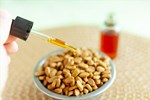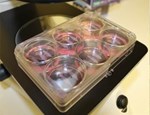Dr Debbie Guest
Department: Clinical Science and Services
Research Groups: Musculoskeletal Biology
Debbie is a senior research fellow carrying out research into companion animal pluripotent stem cells for therapeutic use and disease modelling.
Debbie completed a BSc in genetics at the University of Leeds in 2002 and then went on to undertake a PhD on the transcriptional control of neuronal differentiation in stem cells, which she completed in 2005. Following her PhD she undertook a post-doctoral position at the Equine Fertility Unit in Newmarket to derive and characterise horse embryonic stem cells. In 2007 she moved to the Animal Health Trust and started to investigate the therapeutic potential of embryonic stem cells for treating horse tendon injuries. Since then she has expanded her research into the derivation of induced pluripotent stem cells from horses, dogs and cats with a focus on both their therapeutic applications and use in disease modelling. Debbie joined the RVC as a senior research fellow in 2020.
Debbie was awarded the International Veterinary Regenerative Medicine Society Young scientist award for outstanding research in 2011 and the Petplan Charitable Trust Scientific Award in 20222. She is a member of the International Society for Stem Cell Research (ISSCR) and the Tissue Engineering and Regenerative Medicine International Society (TERMIS). She is a reviewer for numerous scientific journal and grant funding bodies and is an associate editor for Frontiers in Veterinary Science, Regenerative Medicine.
Debbie’s research is centred around the pluripotent stem cells from companion animals (horses, dogs and cats). She has derived and characterised horse embryonic stem cells and has an established research programme to develop novel cell therapies for tendon injuries in horses. Debbie’s group have established 3 dimensional culture protocols for the differentiation of embryonic stem cells into tendon cells and have performed detailed characterisation of the cells to determine their safety and efficacy in tendon regeneration. Her current focus is to identify the mechanisms by which embryonic stem cell derived tendon cells are protected from the effects of inflammation to develop novel drug treatments to aid adult tendon regeneration.
Debbie has also derived induced pluripotent stem cells from horses, dogs and cats to develop “disease in a dish models” to understand the genetic basis for inherited diseases with the aim of developing new interventions and treatments. Her primary focus is on catastrophic bone fractures in Thoroughbred horses, but she is also part of collaborative projects using iPSCs for heart disease in cats and corneal disease in dogs.
E. Palomino Lago, A. Baird, S. C. Blott, R E McPhail, A. C. Ross, D. J Guest. A Functional Single-Nucleotide Polymorphism Upstream of the Collagen Type III Gene Is Associated with Catastrophic Fracture Risk in Thoroughbred Horses. Animals 2024, 14, 116. https://doi.org/10.3390/ani14010116
Palomino Lago, E., Jelbert, E. R., Baird, A., Lam, P. Y. & Guest, D. J. Equine induced pluripotent stem cells are responsive to inflammatory cytokines before and after differentiation into musculoskeletal cell types. In Vitro Cellular & Developmental Biology - Animal, doi:10.1007/s11626-023-00800-3 (2023).
Beaumont RE, Smith EJ, Zhou L, Marr N, Thorpe CT, Guest DJ. Exogenous interleukin-1 beta stimulation regulates equine tenocyte function and gene expression in three-dimensional culture which can be rescued by pharmacological inhibition of interleukin 1 receptor, but not nuclear factor kappa B, signaling. Molecular and Cellular Biochemistry. 2023. doi: 10.1007/s11010-023-04779-z
Melzer, M., Burk, J., Guest, D. J. & Dudhia, J. Influence of Rho/ROCK inhibitor Y-27632 on proliferation of equine mesenchymal stromal cells. Frontiers in veterinary science 10, doi:10.3389/fvets.2023.1154987 (2023).
E. J. Smith, R. E. Beaumont, A. McClellan, C. Sze, E. Palomino Lago, L. Hazelgrove, J. Dudhia, R.K. Smith, D. J. Guest (2022) "Tumour necrosis factor alpha, Interleukin 1 beta and Interferon gamma have detrimental effects on equine tenocytes that cannot be rescued by IL-1RA or mesenchymal stromal cell-derived factors" Cell and Tissue Research, doi: 10.1007/s00441-022-03726-6.
Webb, T. L., Spaas, J. H. & Guest, D. J. Editorial: One Health and Veterinary Regenerative Medicine: Translational Applications. Frontiers in veterinary science 9, doi:10.3389/fvets.2022.959564 (2022).
D. J. Guest, J. Dudhia, R. K. Smith, S. Roberts, M. Conzemius, J.F. Innes, L. Fortier and R. L. Meeson. (2022) Position Statement: Minimal criteria for reporting veterinary and animal medicine research for mesenchymal stromal/stem cells in orthopaedic applications. Frontiers in Veterinary Science. 9, 10.3389/fvets.2022.817041.
Guest DJ (2020). Equine induced pluripotent stem cells. In A Birbrair (Ed.), iPSCs from diverse species (pp. 59-75). Elsevier Academic Press
Paterson, YZ, Evans N, Kan S, Cribbs A, Henson FMD, Guest DJ (2020). The transcription factor scleraxis differentially regulates gene expression in tenocytes isolated at different developmental stages. Mech Dev. 163, 103635.
Paterson, YZ, Cribbs A, Espenel M, Smith EJ, Henson FMD, Guest DJ (2020). Genome-wide transcriptome analysis reveals equine embryonic stem cell-derived tenocytes resemble fetal, not adult tenocytes. Stem Cell Res Ther. 11 (1):184.
Atkinson F, Evans R, Guest JE, Bavin EP, Cacador D, Holland C, Guest DJ (2020). Cyclical strain improves artificial equine tendon constructs in vitro. J Tissue Eng Regen Med. 2020 14(5):690-700.
Kafarnik, C., McClellan, A., Dziasko, M., Daniels, J. T., Guest, D. J. (2020). Canine Corneal Stromal Cells have multipotent mesenchymal stromal cell properties in vitro. Stem Cells Dev. 29(7):425-439.
Liao, X., Falcon, N., Mohammed, A., Paterson, Y., Mayes, A., Guest, D. J., & Saeed, A. (2020). Synthesis and formulation of four-arm PolyDMAEA/siRNA polyplex for transient downregulation of collagen type III gene expression in TGF-β1 stimulated tenocyte culture. ACS Omega. 5(3):1496-1505
McClellan, A., Paterson, Y. Z., Paillot, R. & Guest, D. (2019).Equine fetal, adult and embryonic stem cell derived tenocytes are all immune privileged but exhibit different immune suppressive properties in vitro. Stem Cells Dev. 28(21), 1413-1423.
Dutton, L., Dudhia, J., Guest, D. J. and Connolly, D. J. (2019) Inducing pluripotency in the domestic cat (Felis Catus). Stem Cells Dev. 28(19),1299-1309.
Singh, Y., H. Leinonen, F. Fazaludeen, M. Jaronen, D. Guest, N. Buckley, N. Byts, P. Oksa, K. Jalkanen, I. Iqbal, M. Huuskonen, E. Savchenko, V. Keksa-Goldsteine, S. Chew, J. Myllyharju, H. Tanila, L. Ooi, J. Koistinaho, K. M. Kanninen and T. Malm (2019). "Loss of Cln5 leads to altered Gad1 expression and deficits in interneuron development in mice." Hum Mol Genet. 28(19):3309-3322.
McClellan, A., Evans, R., Sze, C., Kan, S., Paterson, Y., and Guest, D.J. (2019). A novel mechanism for the protection of embryonic stem cell derived tenocytes from inflammatory cytokine interleukin 1 beta. Scientific Reports 9(1), 2755.
Baird, A., Dominguez-Falcon, N., Saeed, A., and Guest, D. J. (2019). Biocompatible 3D printed thermoplastic scaffolds for osteoblast differentiation of equine iPS cells. Tissue Eng Part C Methods. 25(5), 253-261.
Baird, A., Lindsay, T., Everett, A., Iyemere, V., Paterson Y. Z., McClellan, A., Henson, F.M.D. & Guest, D. J. (2018) Osteoblast differentiation of equine induced pluripotent stem cells. Biology Open. doi: 10.1242/bio.033514. 10;7(5).
Paterson, Y. Z., Kafarnik, C. & Guest, D. J. (2018) Characterisation of companion animal pluripotent stem cells. Cytometry A. 93(1), 137-148.
Bavin, E. P., Atkinson, F., Barsby, T. & Guest, D. J. (2017) Scleraxis is essential for tendon differentiation by equine embryonic stem cells and in equine fetal tenocytes. Stem Cells and Development. 26(6):441-450.
Bavin, E. P, Smith, O., Baird, A.E, Smith, L.C., & Guest, D.J. (2015) Equine Induced Pluripotent Stem Cells have a Reduced Tendon Differentiation Capacity Compared to Embryonic Stem Cells. Frontiers in Veterinary Science, 2, 55.
Broeckx, S.Y, Borena, B., Van Hecke, L., Chiers, K., Maes, S., Guest, D.J., Meyer, E., Duchateau, L., Martens, A., & Spaas, J.H. (2015) Comparison of autologous versus allogeneic epithelial-like stem cell treatment in an in vivo equine skin wound model. Cytotherapy. 17(10):1434-46
Baird, A.E.G, Barsby, T. & Guest, D.J. (2015) Derivation of canine induced pluripotent stem cells. Reproduction in Domestic Animals. ;50(4):669-76.
Paterson Y. Z., Rash, N., Garvican, E. R., Paillot, R., & Guest, D.J. (2014) Equine mesenchymal stromal cells and embryo-derived stem cells are immune privileged in vitro. Stem Cell Research and Therapy. 5, 90.
Barsby, T., Bavin, E. & Guest D. J. (2014) 3-Dimensional Culture and Transforming Growth Factor Beta3 Synergistically Promote Tenogenic Differentiation of Equine Embryo-Derived Stem Cells. Tissue Engineering Part A. 20, 2604-2613.
Broeckx S, de Vries C, Suls M, Guest DJ, Spaas JH (2013) Guidelines to Optimize Survival and Migration Capacities of Equine Mesenchymal Stem Cells. J Stem Cell Res Ther 3: 147.
Barsby, T. & Guest, D. J. (2013) Transforming Growth Factor Beta3 Promotes Tendon Differentiation of Equine Embryo-Derived Stem Cells. Tissue Engineering Part A. 19(19-20)2156-2165.
Spaas, J. H., Guest, D. J., Van de Walle, G. R. (2012) Tendon Regeneration in Human and Equine Athletes: Ubi Sumus-Quo Vadimus (Where are We and Where are We Going to)? Sports Medicine. 42(10)871-890.
Guest, D. J., Smith, M. R. W. & Allen, W. R. (2010) Equine embryonic stem-like cells and mesenchymal stromal cells have different survival rates and migration patterns following their injection into damaged superficial digital flexor tendons. Equine Veterinary Journal. 42(7), 636-642.
Guest, D. J., Ousey, J. C., and Smith, M. R. W. (2008) Defining the expression of marker genes in equine mesenchymal stromal cells. Stem Cells and Cloning: Advances and Applications. 1, 1-9.
Guest, D. J., Smith, M. R. W., and Allen, W. R. (2008). Monitoring the fate of autologous and allogeneic mesenchymal progenitor cells injected into the superficial digital flexor tendon of horses: preliminary study. Equine Veterinary Journal. 40, 178-181.
Johnson, R., Zuccato, C., Belyaev, N. D., Guest, D. J., Cattaneo, E., and Buckley, N. J. (2008). A microRNA-based gene dysregulation pathway in Huntington’s disease. Neurobiology of Disease. 29, 438-445.
Guest, D. J. and Allen, W. R. (2007). Expression of cell-surface antigens and embryonic stem cell pluripotency genes in equine blastocysts. Stem Cells and Development. 16, 789-795.
Greenway, D. J*. & Allen, W. R. (2007). Horse stem cells in development and therapies. Reproduction in Domestic Animals. 42(Suppl. 2) 68-68.
Greenway, D. J*., Street, M., Jefferies, A., and Buckley, N. J. (2007). RE1 silencing transcription factor maintains a repressive chromatin environment in embryonic hippocampal neural stem cells. Stem Cells. 25, 354-363.
Sun, Y., Greenway, D. J.*, Johnson, R., Street, M., Belyaev, N. D., Deuchars, J., Bee, T., Wilde, S., and Buckley, N. J. (2005). Distinct profiles of REST interactions with its target genes at different stages of neuronal development. Molecular Biology of the Cell. 16, 5640-5638.
*maiden name
Debbie supervises both undergraduate and post-graduate research student projects.
Debbie has been a STEM (science, technology, engineering and maths) ambassador since 2011 to engage pupils in all stages of education with science.
-
CornealCellVision: Derivation of corneal keratocytes from canine induced pluripotent stem cells to develop disease models and novel treatments for corneal disease
This project will generate corneal stromal tissue in the laboratory to pave the way to the development of an artificial cornea for future disease modelling and clinical transplantation into injured and diseased dog eyes to restore vision. . Corneal diseases are one of the most common debilitating source of visual loss that may lead to permanent blindness in humans as well as in animals.
-
Understanding the genetic basis of catastrophic bone fracture in Thoroughbred horses using stem cells.
Bone fractures are a significant welfare problem in the Thoroughbred racing industry. Previous work has demonstrated that fracture is a complex condition with both environmental and genetic factors risk factors. However, the specific genetic factors that underpin fracture risk have not been identified. This has proved problematic to work out using patients due to the difficulty in accessing bone tissue and the large variability in exposure to environmental risk factors.
-
Using pluripotent stem cells to improve tendon regeneration in horses
Tendon injuries are common in horses taking part in a wide range of disciplines. After an injury, adult tendons undergo poor natural regeneration, instead repairing with functionally inferior scar tissue which leads to high re-injury rates.
Improving tendon regeneration is therefore key to reducing re-injury rates and enabling more horses to return to work following an injury.



